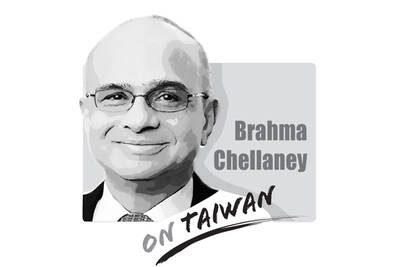The name of a street, a town or a location in Taiwan often has special meaning and reflects the nation’s complex history. For example, Roosevelt Road in Taipei was named in memory of former US president Franklin D. Roosevelt, while the Barclay Memorial Park in Greater Tainan was named after Reverend Thomas Barclay, a Briton, for his contribution to the city.
Greater Taichung’s Fengyuan District (豐原), with its name coming from the translation of Toyohara, was among numerous townships and cities that shared a history under the Japanese colonial period.
At the same time, street names like Zhongzhen Road, Zhongshan Road, Qinghai Road and Changsha Road, among others, which were named after Chinese cities by the Chinese Nationalist Party (KMT) regime following its flight from China in 1949, are found in almost every city.
Although many Taiwanese do not like the names, they have been etched into people’s daily lives.
However, two incidents related to names in the past week raised people’s attention and triggered protests.
People in Changhua County launched an online protest against the county government after its Department of Agriculture renamed Xizhou Park in Xizhou Township (溪洲) to Fitzroy Park, with residents saying that the name had nothing to do with the township.
Officials said the inspiration came from an inspection visit to Melbourne’s Fitzroy Gardens, but they have agreed to review the name if the public finds it unacceptable.
In Greater Taichung, the city government decided that the Chinese-language name of Taichung Gateway Park, a 251 hectare project on the site of the old Shuinan airport, would be “Dazaiman District” (大宅門), although its English name would remain unchanged.
Dazaiman comes from a Beijing-based Chinese TV series inspired by a book of the same name that aired on local cable TV.
Blasted by local advocates and city councilors across party lines over the move, the city government has nonetheless refused to reverse its decision.
The incidents show how local governments have misused and distorted the concept of internationalization and how they were unaware that the ideology of Sinicization had long been planted in their brains.
Internationalization is a far more complex and difficult issue than merely changing the name of something. If officials in Changhua County were serious about making the county one of the most livable places in the nation, they should realize that it will perhaps take 20 years of hard work with no shortcuts.
The Xizhou incident also highlights officials’ lack of understanding of Taiwanese identity and the people’s sense of connection, bond and pride with the history of the place in which they live. Naming the park after a foreign attraction was one of the worst ideas possible.
The incident in Greater Taichung has raised an even more serious concern over the deeply ingrained “Greater China” ideology of KMT officials. While they could have easily named the project the Beverly Hills gateway park, they chose Dazaiman.
From the central government, which is trying to overhaul the high-school history textbook outlines to better serve its “Greater China” perspective, down to the local governments, the KMT administration has devoted every bit of its energy to reminding Taiwanese of the nation’s ties and connections with China.
The undertone and the implication of these incidents was perhaps not conspicuous, but it is significant. Be it 1949 or 2014, the nomenclature has been always one of the better ways for people to judge the KMT’s claim that Taiwan is its home, and that it would do everything it could to safeguard the nation and make it a better place.
I came to Taiwan to pursue my degree thinking that Taiwanese are “friendly,” but I was welcomed by Taiwanese classmates laughing at my friend’s name, Maria (瑪莉亞). At the time, I could not understand why they were mocking the name of Jesus’ mother. Later, I learned that “Maria” had become a stereotype — a shorthand for Filipino migrant workers. That was because many Filipino women in Taiwan, especially those who became house helpers, happen to have that name. With the rapidly increasing number of foreigners coming to Taiwan to work or study, more Taiwanese are interacting, socializing and forming relationships with
Chinese social media influencer “Yaya in Taiwan” (亞亞在台灣), whose real name is Liu Zhenya (劉振亞), made statements advocating for “reunifying Taiwan [with China] through military force.” After verifying that Liu did indeed make such statements, the National Immigration Agency revoked her dependency-based residency permit. She must now either leave the country voluntarily or be deported. Operating your own page and becoming an influencer require a certain amount of support and user traffic. You must successfully gain approval for your views and attract an audience. Although Liu must leave the country, I cannot help but wonder how many more “Yayas” are still

Earlier signs suggest that US President Donald Trump’s policy on Taiwan is set to move in a more resolute direction, as his administration begins to take a tougher approach toward America’s main challenger at the global level, China. Despite its deepening economic woes, China continues to flex its muscles, including conducting provocative military drills off Taiwan, Australia and Vietnam recently. A recent Trump-signed memorandum on America’s investment policy was more about the China threat than about anything else. Singling out the People’s Republic of China (PRC) as a foreign adversary directing investments in American companies to obtain cutting-edge technologies, it said
The recent termination of Tibetan-language broadcasts by Voice of America (VOA) and Radio Free Asia (RFA) is a significant setback for Tibetans both in Tibet and across the global diaspora. The broadcasts have long served as a vital lifeline, providing uncensored news, cultural preservation and a sense of connection for a community often isolated by geopolitical realities. For Tibetans living under Chinese rule, access to independent information is severely restricted. The Chinese government tightly controls media and censors content that challenges its narrative. VOA and RFA broadcasts have been among the few sources of uncensored news available to Tibetans, offering insights